Himachal Pradesh
| ?Himachal Pradesh India |
|
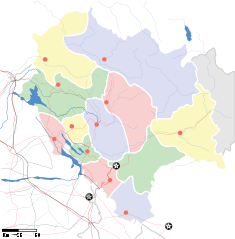

|
|
| Coordinates: | |
| Time zone | IST (UTC+5:30) |
| Area | 56,019 km² (21,629 sq mi) |
| Capital | Shimla |
| Largest city | Shimla |
| District(s) | 12 |
| Population • Density |
6,077,248 (20th) • 109 /km² (282 /sq mi) |
| Language(s) | Hindi, Pahari, Punjabi |
| Governor | Prabha Rau |
| Chief Minister | Prem Kumar Dhumal |
| Established | 25 January 1971 |
| Legislature (seats) | Unicameral (68) |
| ISO abbreviation | IN-HP |
| Website: himachal.nic.in | |
 |
|
Himachal Pradesh (Hindi: हिमाचल प्रदेश, Punjabi: ਹਿਮਾਚਲ ਪ੍ਰਦੇਸ਼, pronounced [hɪmaːtʃəl prəd̪eːʃ]) is a state in the Punjab region in north-west India. Himachal Pradesh is spread over 21,629 sq mi (56,019 km²),[1] and is bordered by the Indian states of Jammu and Kashmir on north, Punjab on west and south-west, Haryana and Uttar Pradesh on south, Uttarakhand on south-east and by Tibet on the east. The literal meaning of Himachal Pradesh is Region of snowy mountains.[2]
Himachal Pradesh was also known as Deva Bhoomi (the land of the gods). The Aryan influence in the region dates back to the period before the Rigveda. After the Anglo Gorkha war, the British colonial government came into power. It was initially in Punjab, except Siba State of Punjab Hills, under the rule of Maharaja Ranjit Singh till 1857 [3] In 1950 Himachal was declared as the union territory but after State of Himachal Pradesh Act 1971 Himchal emerged as the 18th state of Indian Union.
Himachal Pradesh has one of the highest per capita incomes of any state in India. Due to the abundance of perennial rivers, Himachal also sells hydro electricity to other states such as Delhi, Punjab & Rajasthan.[4] The economy of the state is highly dependent on three sources: hydroelectric power, tourism and agriculture.[5]
Hindus make up 90% of the state population. The major communities are of Brahmins, Rajputs, Kannets, Rathis and Kolis. According to a 2005 Transparency International survey, Himachal Pradesh is ranked the second-least corrupt state in the country after Kerala.[6]
Contents |
History
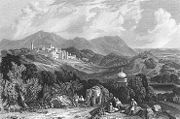
The history of the area that now constitutes Himachal Pradesh dates back to the time when the Indus valley civilisation flourished between 2250 and 1750 BCE.[7] Tribes such as the Koilis, Halis, Dagis, Dhaugris, Dasa, Khasas, Kinnars and Kirats inhabited the region from pre-histotic era. During the Vedic period, several small republics known as "Janapada" existed which were later conquered by the Gupta Empire.[8] After a brief period of supremacy by king Harshavardhana, the region was once again divided into several local powers headed by chieftains, including some Rajput prinicipalities. These kingdoms that enjoyed a large degree of independence were devastated by Muslim invaders a number of times.[7] Mahmud Ghaznavi conquered Kangra at the beginning of the 10th century. Timur and Sikander Lodi also marched through the lower hills of the state and captured a number of forts and fought many battles.[7] Several hill states acknowledged Mughal suzerainty and paid regular tribute to the Mughals.[9]
The Gorkhas, a martial tribe came to power in Nepal in the year 1768.[7] They consolidated their military power and began to expand their territory.[7] Gradually the Gorkhas annexed Sirmour and Shimla. With the leadership of Amar Singh Thapa, Gorkhas laid siege to Kangra. They managed to defeat Sansar Chand, the ruler of kangra, in 1806 with the help of many provincial chiefs. However Gorkhas could not capture Kangra fort which came under Maharaja Ranjeet Singh in 1809. After the defeat the Gorkhas began to expand towards the south of the state.However,Raja Ram Singh,Raja of Siba State re-captured the fort of Siba from the army of Maharaja Ranjit Singh in Samvat 1846.[7]
This led in the Anglo-Sikh war. They came into direct conflict with the British along the tarai belt after which the British expelled them from the provinces of the Satluj.[7] Thus the British gradually emerged as the paramount powers.[7] The revolt of 1857 or first Indian war of independence resulted due to the building up of political, social, economic, religious and military grievances against the British government.[7] People of the hill states were not politically alive as the people in other parts of the country.[7] They remained more or less inactive and so did their rulers with the exception of Bushahr.[7] Some of them even rendered help to the British government during the revolt. Among them were the rulers of Chamba, Bilaspur, Bhagal and Dhami. The rulers of Bushars rather acted in a manner hostile to the interests of British.[7]
The British territories in the hill came under British Crown after Queen Victoria's proclamation of 1858. The states of Chamba, Mandi and Bilaspur made good progress in many fields during the British rule.[7] During World War I, virtually all rulers of the hill states remained loyal and contributed to the British war effort both in the form of men and materials. Amongst these were the states of Kangra, Jaswan,Datarpur,Guler, Nurpur, Chamba, Suket, Mandi and Bilaspur.[7]
After independence the Chief Commissioner's province of H.P. came into being on 15 April, 1948. The province comprised the hill districts around Shimla and southern hill areas of the former Punjab region. Himachal became a part C state on 26 January, 1950 with the implementation of the Constitution of India. Himachal Pradesh became Union Territory on 1 November, 1956.[7] On 18 December, 1970 the State of Himachal Pradesh Act was passed by Parliament and the new state came into being on 25 January, 1971. Thus Himachal emerged as the eighteenth state of Indian Union.[7]
Geography and climate

Himachal is situated in the western Himalayas. Covering an area of 55,780 kilometres (34,660 mi),[1] Himachal Pradesh is a mountainous state with elevation ranging from about 350 metres (1,148 ft) to 6,000 metres (19,685 ft) above the sea level.[10]

The drainage system of Himachal is composed both of rivers and glaciers. Himalayan rivers criss-cross the entire mountain chain. In fact the rivers are older than the mountain system. [11] Himachal Pradesh provides water to both the Indus and Ganges basins.[12] The drainage systems of the region are the Chandra Bhaga or the Chenab, the Ravi, the Beas, the Sutlej and the Yamuna. These rivers are perennial and are fed by snow and rainfall. They are protected by an extensive cover of natural vegetation. [12]
There is great variation in the climatic conditions of Himachal due to extreme variation in elevation. The climate varies from hot and sub-humid tropical in the southern tracts to cold, alpine and glacial in the northern and eastern mountain ranges with more elevation.[13] The state has areas like Dharamsala that receive very heavy rainfall, as well as those like Lahaul and Spiti that are cold and almost rainless. Broadly Himachal experience three seasons; hot weather season, cold weather season and rainy season. Summer lasts from mid April till the end of June and most parts become very hot (except in alpine zone which experience mild summer) with the average temperature ranging from 28 °C (82 °F) to 32 °C (90 °F). Winter lasts from late November till mid March. Snowfall is common in alpine tracts (generally above 2,200 metres (7,218 ft) i.e. in the Higher and Trans-Himalayan region).
Flora and fauna
According to 2003 Forest Survey of India report, legally defined forest areas constitute 66.52% of the area of Himachal Pradesh, although area under tree cover is only 25.78%.[14] Vegetation in the state is dictated by elevation and precipitation. The southern part of the state which is at lower elevation has both tropical and subtropical dry broadleaf forests and tropical and subtropical moist broadleaf forests.[14] A part of the Himalayan subtropical broadleaf forests, the vegetation is dominated by sal, sisham, chir pine, dry deciduous and moist broad-leafed forests. The temperate region grows oaks, deodar, blue pine, fir and spruce. In the uppermost region, trees are sturdy with a vast network of roots. Alders, birches, rhododendrons and moist alpine scrubs are there as the regional vegetation. The rhododendrons can be seen along the hillsides around Shimla from March to May.
Himachal is also said to be the fruit bowl of the country with orchards scattered all over the place. Meadows and pastures are also seen clinging to steep slopes. After the winter season, the hillsides and orchards bloom with wild flowers, while gladiolas, carnations, marigolds, roses, chrysanthemums, tulips and lilies are carefully cultivated. The state government is gearing up to make Himachal Pradesh as the flower basket of the world.
Himachal Pradesh is a well known habitat to a variety of animals. There are around 1200 bird and 359 animal species in the state.[15] This includes the leopards, ghoral, snow leopard, musk deer (the state animal) and Western Tragopan (the state bird). It has 12 major national parks and sanctuaries – the largest number in the Himalayan region. The Great Himalayan National Park in Kullu district was created to conserve the flora and fauna of the main Himalayan range, while the Pin Valley National Park to conserve the flora and fauna of the cold desert.
Subdivisions

Himachal Pradesh is divided into 12 districts namely, Kangra, Hamirpur, Mandi, Bilaspur, Una, Chamba, Lahul and Spiti, Sirmaur, Kinnaur, Kullu, Solan and Shimla. The state capital is Shimla which was formerly British India's summer capital under the name Simla.
A district of Himachal Pradesh is an administrative geographical unit, headed by a Deputy Commissioner or District Magistrate, an officer belonging to the Indian Administrative Service. The district magistrate or the deputy commissioner is assisted by a number of officers belonging to Himachal Administrative Service and other Himachal state services. Each district is subdivided into Sub-Divisions, governed by a sub-divisional magistrate, and again into Blocks. Blocks consists of panchayats (village councils) and town municipalities. A Superintendent of Police, an officer belonging to the Indian Police Service is entrusted with the responsibility of maintaining law and order and related issues of the district. He is assisted by the officers of the Himachal Police Service and other Himachal Police officials.
Government
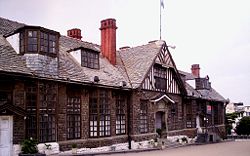
The Himachal Pradesh Legislative Assembly has no pre-Constitution history. The State itself is a post-Independence creation. It came into being as a centrally administered territory on 15 April 1948 from the integration of thirty erstwhile princely states.[16]
Himachal Pradesh is governed through a parliamentary system of representative democracy, a feature the state shares with other Indian states. Universal suffrage is granted to residents. The legislature consists of elected members and special office bearers such as the Speaker and the Deputy Speaker who are elected by the members. Assembly meetings are presided over by the Speaker or the Deputy Speaker in the Speaker's absence. The judiciary is composed of the Himachal Pradesh High Court and a system of lower courts. Executive authority is vested in the Council of Ministers headed by the Chief Minister, although the titular head of government is the Governor. The Governor is the head of state appointed by the President of India. The leader of the party or coalition with a majority in the Legislative Assembly is appointed as the Chief Minister by the Governor, and the Council of Ministers are appointed by the Governor on the advice of the Chief Minister. The Council of Ministers reports to the Legislative Assembly. The Assembly is unicameral with 68 Members of the Legislative Assembly (MLA).[17] Terms of office run for 5 years, unless the Assembly is dissolved prior to the completion of the term. Auxiliary authorities known as panchayats, for which local body elections are regularly held, govern local affairs.
Governments have seen alternates between Bharatiya Janata Party (BJP) & Indian National Congress (INC), no third front ever has become significant. In 2003, the state legislative assembly was won by the Indian National Congress and Virbhadra Singh was elected as the chief minister of the state. In the assembly elections held in December 2007, the BJP secured a landslide victory. The BJP won 41 of the 68 seats while the Congress won only 23 of the 68 seats. BJP's Prem Kumar Dhumal was sworn in as Chief Minister of Himachal Pradesh on 30 December, 2007
Economy
| Gross State Domestic Product at Current Prices
figures in millions of Indian Rupees |
|
| Year | Gross State Domestic Product |
|---|---|
| 1980 | 7,940 |
| 1985 | 13,720 |
| 1990 | 28,150 |
| 1995 | 66,980 |
| 2000 | 135,900 |
| 2005 | 230,240 |
| 2007 | 254,350 |
The era of planning started in Himachal in 1948 along with the rest of India. The first five year plan allocated Rs.5.27 crore to Himachal. More than 50% of this expenditure was incurred on road construction since it was felt that without proper transport facilities, the process of planning and development could not be carried to the people, who mostly lived an isolated existence in far away areas. Himachal now ranks fourth in respect of per capita income among the states of the Indian Union.[4]
Agriculture contributes over 45% to the net state domestic product. It is the main source of income and employment in Himachal. Over 93% of the population in Himachal depend directly upon agriculture which provides direct employment to 71% of its people. The main cereals grown are wheat, maize, rice and barley.
Himachal has a rich heritage of handicrafts. These include woolen and pashmina shawls, carpets, silver and metal ware, embroidered chappals, grass shoes, Kangra and Gompa style paintings, wood work, horse-hair bangles, wooden and metal utensils and various other house hold items. These aesthetic and tasteful handicrafts declined under competition from machine made goods and also because of lack of marketing facilities. But now the demand for handicrafts has increased within and outside the country.
Himachal is extremely rich in hydel resources. The state has about 25% of the national potential in this respect. It has been estimated that about 20,300MW of hydel power can be generated in the State by constructing various major, medium, small and mini/micro hydel projects on the five river basins. The state is also the first state in India to achieve the goal of having a bank account for every family.[4]
As per the current prices, the total GDP was estimated at Rs 25,435 crore (Rs 254,350,000,000), as against Rs 23,024 crore (Rs 230,240,000,000) in the year 2004-05, showing an increase of 10.5%.[18]
Transport
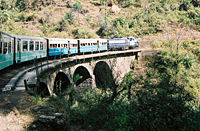
Roads are the major mode of transport in the hilly terrains of Himachal Pradesh. The state has road network of 28,208 km (17,528 mi),[19] including eight national highways (NH) that constitute 1,234 km (767 mi).[19] Some roads get closed during winter and monsoon seasons due to snowfall and landslides. Regular bus services connect Shimla with Chandigarh, Kullu, Manali, Delhi, Mandi, Pathankot, Ambala, Chail and Dehradun. Local taxis are the major local transport here. District Hamirpur has got the highest road density in the country.[20]
Railway track is accessible only to a few places in Himachal Pradesh. The Pathankot–Jogindernagar line connectsPunjab with Himachal Pradesh. The other railway tracks pass through Shimla, Solan and Una. Shimla is connected with Kalka by a narrow gauge railway line, which in turn is connected with the major cities in India. Himachal has two narrow gauge rail tracks. The Kalka-Shimla Railway track has a length of 96 kilometers. It passes through 102 tunnels and crosses 864 bridges.[21][22]
There are three domestic airports in the state—Shimla Airport, Bhuntar Airport serving Kullu and Manali, and Gaggal Airport serving Kangra and Dharamsala. The air routes connect the state with Delhi and Chandigarh. There are no international airports in Himachal Pradesh. Jagson Airlines has flights from Delhi to Shimla.[23]
Demographics
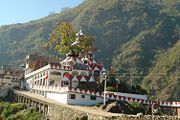
The population of Himachal in 2001 stood at 6,077,248 as per the provisional results of the Census of India 2001.[24] The population of Himachal Pradesh includes estimated population of entire Kinnaur district, where the population enumeration of Census of India, 2001 could not be conducted due to natural calamity.[24] In terms of population it holds the same position (twenty first) among States and Union territories as at the previous census.[24] The population of the State rose by 17.53% between 1991-2001.[24] The sex ratio (i.e., the number of females per thousand males) of population was recorded as 970, which has declined from 976 in the previous census.[24] Total literacy of the State rose to 77.13% from 63.94% in 1991.[24]
The tribal population of the state comprise of the Gaddis, Kinnars, Gujjars, Pangawals, Lahaulis and Spitians.[25] The Gaddis are the traditional shepherds who migrate from the alpine pastures to the lower regions during the winters. The Kinnars are the inhabitants of the Kinnaur region and have traditionally practiced polyandry and polygamy. The Gujjars are nomads who rear buffalo herds. Himachal also has a sizeable population of Tibetans[25]
About 95.4% of the population of Himachal Pradesh consists of Hindus, Muslims 2.0%, Sikhs 1.2% and Buddhists 1.2% [26]. Their main communities are Brahmins, Rajputs, Kannets, Rathis and Kolis. Himachal Pradesh has the highest proportion of Hindu population in India. Other religions are Sikhism and Buddhism. The Lahaulis of Lahaul and Spiti region are mainly Buddhists.[24]
The major spoken languages include Hindi, Punjabi, Mahasui, Kulluyi, Lahauli, Kinnauri, Chambyali, Sirmauri, Bilaspuri, Pahari, Dogri, Kangri.[25]
The life expectancy at birth in Himachal Pradesh is 62.8 years (higher than the national average of 57.7 years) for the period 1986–1990. The Infant mortality rate stood at 62 in 1999 and crude birth rate has declined from 37.3 in 1971 to 22.6 in 1998, below the national average of 26.5 in 1998. The crude death rate was 7.7 in 1998 while the total fertility rate (TFR) has declined from 4.7 to 3.6. Himachal Pradesh's literacy rate grew by 34.65% between the period 1981 and 2001.[27]
Languages of the Sino-Tibetan languages spoken in Himachal Pradesh are the Sunam language 558 (1998), Gahri language 4,000 (1997), Jangshung language 1,990 (1998),Kanashi language 1,400 (2002 Chauhan), Kinnauri language 48,778, Kinnauri Bhoti language 6,000 (1998), Chitkuli language 1,060 (1998), Pattani language 11,000 (1997), Shumcho language 2,174 (1998) and the Tukpa language 723 (1998).[28]
Culture
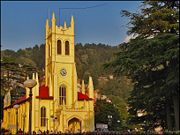
Himachal was one of the few states that had remained largely untouched by external customs, largely due to its difficult terrain. With the technological advancements the state has changed very rapidly. It is a multireligional, multicultural as well as multilingual state like other Indian states. Some of the most commonly spoken languages includes Hindi, Punjabi, Pahari, Dogri, Kangri and Kinnauri.[25] The Hindu caste communities residing in Himachal include the Brahmins, Rajputs, Kannets, Rathis and Kolis.[29] There are also tribal population in the state which mainly comprise Gaddis, Kinnars, Gujjars, Pangawals, Sulehri and Lahaulis.[30]
The state is well known for its handicrafts. The carpets, leather works, shawls, paintings, metalware, woodwork and paintings are worth appreciating. Pashmina shawl is one of the product which is highly in demand not only in Himachal but all over the country. Himachali caps are also famous art work of the people. Extreme cold winters of Himachal necessitated wool weaving. Nearly every household in Himachal owns a pit-loom. Wool is also considered as pure and is used as a ritual cloth. The well known woven object is the shawl, ranging from fine pashmina to the coarse desar. Kullu is famous for its shawls with striking patterns and vibrant colours.
Local music and dance reflects the cultural identity of the state. Through their dance and music, they entreat their gods during local festivals and other special occasions. Apart from the fairs and festivals that are celebrated all over India, there are number of other fairs and festivals also that are of great significance to Himachal Pradesh.
Shimla, the state capital is home to Asia's only natural Ice skating rink[31].
The day to day food of Himachalis is very similar to the rest of the north India. They too have lentil, broth, rice, vegetables and bread. As compared to other states in north India non vegetarian is more preferred.[30] Some of the specialities of Himachal include Pateer, Chouck, Bhagjery, Patrode, Sidku, Beduan and chutney.
Famous people associated with Himachal include English author Rudyard Kipling, Indian film personalities Dalip Singh Rana, Anupam Kher, Preity Zinta, Amrish Puri (who studied here), and Prem Chopra (brought up here), economist and former vice-president of World Bank Shahid Javed Burki, Satyananda Stokes who introduced apple in the region, writer Idries Shah, ornithologist Allan Octavian Hume (had his home here), former general of Pakistan Muhammad Zia-ul-Haq and current President of Afghanistan Hamid Karzai who both studied here
Education

Himachal Pradesh has one of the highest literacy rates in India.[32] Hamirpur District is among the top districts in the country for literacy.[32] Education rates among women are quite encouraging in the state.[32]
The standard of education in the state has reached to a considerably high level as compared to other states in India.[32] The state has several reputed educational institutes for higher studies.
The Himachal Pradesh University (HPU), Shimla and the NIT, Hamirpur are some of the pioneer institutes located in the state. Dr. Yashwant Singh Parmar University of Horticulture and Forestry has earned a unique distinction in India for imparting teaching, research and extension education in horticulture, forestry and allied disciplines.[32]
The government is working constantly to prepare various plans and projects in order to strengthen the education system of the state. Recently, the State Government has decided to start three nursing colleges to develop the health system in the state. There are over 10,000 primary schools, 1,000 secondary schools and more than 1,300 high schools in Himachal.[33] The state government has decided to start up with 3 major nursing colleges to develop the health system in the state.[32] In meeting the constitutional obligation to make primary education compulsory, Himachal has now became the first state in India to make elementary education accessible to every child in the state.[34]
The State has got Indira Gandhi Medical College and Hospital. Besides that there is Himachal Dental College which is the first recognised Dental Institute in the State.[35]
Media and communication
Though situated in a remote part of the country, Himachal Pradesh has an active community of journalists and publishers. Several newspapers and magazines are published in more than one language, and their reach extends to almost all the Hindi speaking states. Radio and TV have permeated significantly. Judging by the number of people writing to these media, there is a very large media-aware population in the state.
The Telegraph, The Statesman, Asian Age, Hindustan Times, Punjab Kesari and The Times of India are the newspapers published here. Vernacular newspapers such as those in Hindi, Punjabi and Nepali are also read by selected readership.
Doordarshan is the state-owned television broadcaster. Multi system operators provide a mix of Nepali, Hindi, English, and international channels via cable. All India Radio is a public radio station. Private FM stations are also available in few cities like Shimla. BSNL, Reliance Infocomm, Tata Indicom, and Airtel are available cellular phone operators. Broadband internet is available in select towns and cities and is provided by the state-run BSNL and by other private companies. Dial-up access is provided throughout the state by BSNL and other providers.
Notes
- ↑ 1.0 1.1 "Statistical Facts about India". www.indianmirror.com. Retrieved on 2006-10-26.
- ↑ "Literal meaning of Himachal Pradesh". www.himachalpradesh.us. Retrieved on 2007-05-20.
- ↑ "History section". Suni system (P). Retrieved on 2007-04-28.
- ↑ 4.0 4.1 4.2 "Economy of Himachal Pradesh". Suni System (P). Retrieved on 2006-04-28.
- ↑ NEW ERA OF ECONOMIC DEVELOPMENT IN HIMACHAL PRADESH OPPORTUNITIES AND CHALLENGES EXECUTIVE SUMMARY yesbank.in Retrieved on- April 2008
- ↑ "India Corruption Study - 2005". Transparency International. Retrieved on 2007-05-29.
- ↑ 7.00 7.01 7.02 7.03 7.04 7.05 7.06 7.07 7.08 7.09 7.10 7.11 7.12 7.13 7.14 7.15 "History of Himachal Pradesh". National informatics center, Himachal Pradesh. Retrieved on 2008-03-31.
- ↑ "History of Himachal Pradesh". HimachalPradeshIndia.com. Retrieved on 2008-03-31.
- ↑ Verma, V. "Historical Perspective". The Emergence of Himachal Pradesh: A Survey of Constitutional Developments. Himachal Pradesh (India): Indus Publishing. pp. 28–35. ISBN 8173870357. http://books.google.co.in/books?id=QpWloqN5LTAC&dq=himachal+history&source=gbs_summary_s&cad=0. Retrieved on 2008-03-31.
- ↑ "Himachal at a glance". www.himachalpradesh.us. Retrieved on 2007-05-20.
- ↑ "Rivers in Himachal Pradesh". www.himachalpradesh.us. Retrieved on 2006-10-26.
- ↑ 12.0 12.1 "Rivers in Himachal Pradesh". Suni Systems (P). Retrieved on 2006-04-28.
- ↑ "Climate of Himachal Pradesh". www.himachalpradesh.us. Retrieved on 2006-10-26.
- ↑ 14.0 14.1 Himachal Pradesh Forest Department. "The Forests". National Informatics Center, Himachal Pradesh. Retrieved on 2008-04-03.
- ↑ "Fauna". Retrieved on 2007-05-28.
- ↑ "Himachal Pradesh (gov) Introduction". National informatics center. Computer Centre, Lok Sabha Secretariat. Retrieved on 2007-05-03.
- ↑ "Legislative Assembly". Legislative Bodies in India. National Informatics Centre. Retrieved on 2006-10-28.
- ↑ "Current GDP". H. K. Dua, The Tribune House. Retrieved on 2007-05-23.
- ↑ 19.0 19.1 "Himachal Pradesh: Infrastructure". Public Private Partnerships in India. Ministry of Finance, Government of India. Retrieved on 2008-04-06.
- ↑ "Hamirpur road density". Hari Jaisingh, Published from The Tribune House. Retrieved on 2007-05-22.
- ↑ Hughes, H., (1994) Indian Locomotives Part 3, Narrow Gauge, 1863-1940. The Continental Railway Circle, Harrow, UK. ISBN 0-9521655-0-3
- ↑ "MapsOfIndia article on Kalka-Shimla Railway". Retrieved on 2007-03-13.
- ↑ "Transportation in Himachal Pradesh". Himachal Transport Dep. Co.. Retrieved on 2007-01-31.
- ↑ 24.0 24.1 24.2 24.3 24.4 24.5 24.6 "Ethnic composition". The First Report on Religion : Census of India 2001. Archived from the original on 2007-06-15. Retrieved on 2007-01-31.
- ↑ 25.0 25.1 25.2 25.3 "The people and tribes". www.123himachal.com. Retrieved on 2007-05-20.
- ↑ Indian Census
- ↑ "Highlights of Himachal Pradesh HDR (2002)" (PDF). Government of Himachal Pradesh (2002), Himachal Pradesh Human Development Report 2002, Government of Himachal Pradesh, pp. 40. Retrieved on 2007-05-26.
- ↑ "Sino-Tibetan, Tibeto-Burman, Himalayish, Tibeto-Kanauri, Western Himalayish, Kanauri.". Gordon, Raymond G., Jr. (ed.), 2005. Ethnologue: Languages of the World, Fifteenth edition. Dallas, Tex.: SIL International. Retrieved on 2007-07-09.
- ↑ "Ethnicity". Retrieved on 2007-05-24.
- ↑ 30.0 30.1 "Culture of Himachal Pradesh". Indialine (2007). Retrieved on 2007-05-03.
- ↑ "Ice-skating rink completes 100 sessions again". The Tribune, Chandigarh, India. Retrieved on 2001-02-11.
- ↑ 32.0 32.1 32.2 32.3 32.4 32.5 "Educational Profile of Himachal Pradesh". General Overview of Education in Himachal. Pragati Infosoft Pvt. Ltd.. Retrieved on 2007-03-16.
- ↑ "Himachal Govt. Website Factual source on Education in Himachal". Government of India. Retrieved on 2007-03-16.
- ↑ Dua, H.K.. "Educational updates- Himachal". The Tribune Trust, 2006. The Tribune House. Retrieved on 2007-03-16.
- ↑ Indira Gandhi Medical college Retrieved on- April 2008
References
External links
|
|||||||||||||||||||||||||||||||||||||||||